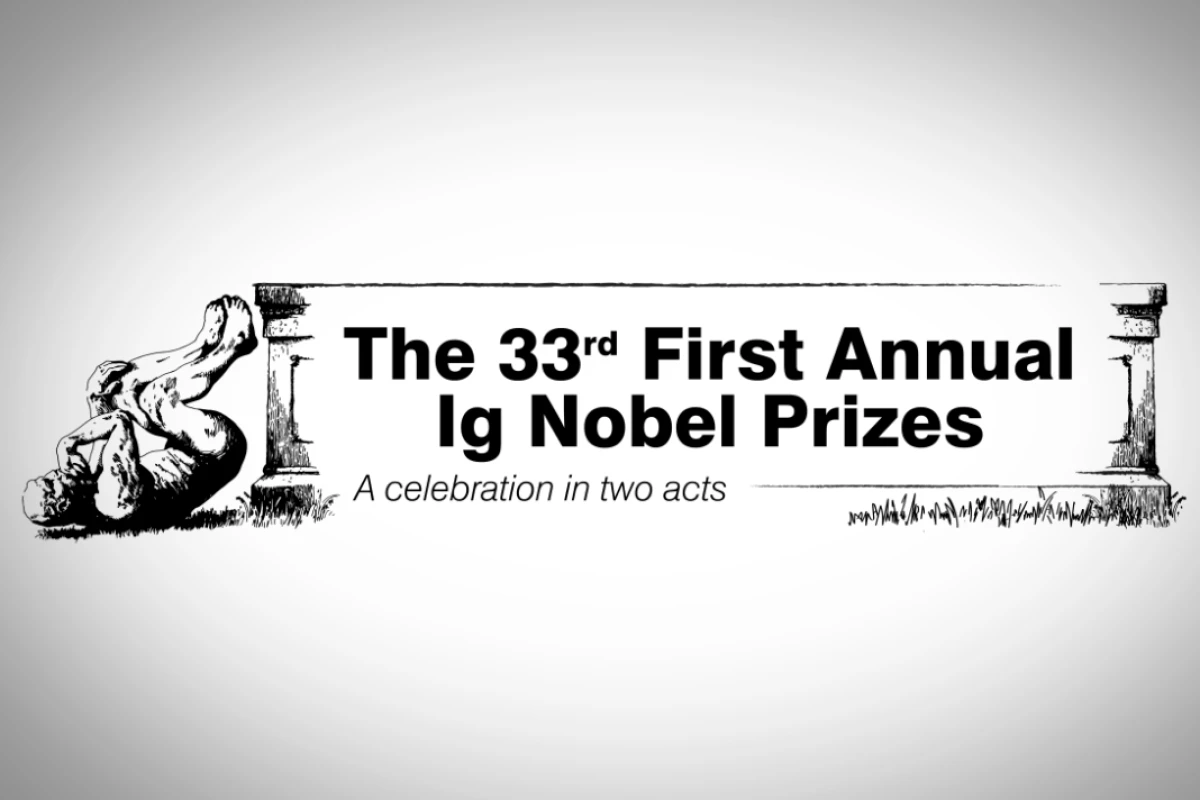The Nobel Prize is the premier award in science, reserved for those that "have conferred the greatest benefit to humankind." The Ig Nobel Prize, on the other hand, celebrates the most trivial and ridiculous things our best and brightest have studied.
The 33rd First Annual Ig Nobel Prizes Ceremony finished earlier today, an entirely online webcast this year, complete with craptastic special effects, some of the world's most deliberately pathetic live intro music, dozens of scientists with clearly mixed feelings on the whole thing, and a lot of silly hats.
The 2023 award winners are now world-class experts that have advanced mankind's knowledge on big questions. Questions like "just how bored do students and teachers get in school?" Or "how much do horny anchovies influence ocean water mixing?" Or "if a group of people stand in the street looking upward, does the size of the group influence how many unrelated passers-by also decide to look up?" Or that old chestnut, "do we need toilets that analyze our excreta and identify us by taking photos of our anuses?"
The winners, presented with "ten billion dollar bills" by a series of bemused Nobel Laureates, were:
CHEMISTRY and GEOLOGY PRIZE
Jan Zalasiewicz, for explaining why many scientists like to lick rocks in the paper, “Eating Fossils.”
LITERATURE PRIZE
Chris Moulin, Nicole Bell, Merita Turunen, Arina Baharin, and Akira O’Connor, for studying the sensations people feel when they repeat a single word many, many, many, many, many, many, many times. Enjoy their paper, “The The The The Induction of Jamais Vu in the Laboratory: Word Alienation and Semantic Satiation."
MECHANICAL ENGINEERING PRIZE
Te Faye Yap, Zhen Liu, Anoop Rajappan, Trevor Shimokusu, and Daniel Preston, for re-animating dead spiders to use as mechanical gripping tools in their paper: “Necrobotics: Biotic Materials as Ready-to-Use Actuators."
PUBLIC HEALTH PRIZE
Seung-min Park, for inventing the Stanford Toilet, a device that uses a variety of technologies – including a urinalysis dipstick test strip, a computer vision system for defecation analysis, an anal-print sensor paired with an identification camera, and a telecommunications link – to monitor and quickly analyze the substances that humans excrete. Here's Park's paper, “A Mountable Toilet System for Personalized Health Monitoring via the Analysis of Excreta."
COMMUNICATION PRIZE
María José Torres-Prioris, Diana López-Barroso, Estela Càmara, Sol Fittipaldi, Lucas Sedeño, Agustín Ibáñez, Marcelo Berthier, and Adolfo García, for studying the mental activities of people who are expert at speaking backward in their paper, "Neurocognitive Signatures of Phonemic Sequencing in Expert Backward Speakers.”
MEDICINE PRIZE
Christine Pham, Bobak Hedayati, Kiana Hashemi, Ella Csuka, Tiana Mamaghani, Margit Juhasz, Jamie Wikenheiser, and Natasha Mesinkovska, for using cadavers to explore whether there is an equal number of hairs in each of a person’s two nostrils. Don't miss their riveting work “The Quantification and Measurement of Nasal Hairs in a Cadaveric Population.”
NUTRITION PRIZE
Homei Miyashita and Hiromi Nakamura, for experiments to determine how electrified chopsticks and drinking straws can change the taste of food in their paper, “Augmented Gustation Using Electricity.”
EDUCATION PRIZE
Katy Tam, Cyanea Poon, Victoria Hui, Wijnand van Tilburg, Christy Wong, Vivian Kwong, Gigi Yuen, and Christian Chan, for methodically studying the boredom of teachers and students. If anything could be more exciting than boredom, it's surely their paper, “Boredom Begets Boredom: An Experience Sampling Study on the Impact of Teacher Boredom on Student Boredom and Motivation.”
PSYCHOLOGY PRIZE
Stanley Milgram, Leonard Bickman, and Lawrence Berkowitz, for experiments on a city street to see how many passers-by stop to look upward when they see strangers looking upward. They explore the subject deeply in their paper, “Note on the Drawing Power of Crowds of Different Size.”
PHYSICS PRIZE
Bieito Fernández Castro, Marian Peña, Enrique Nogueira, Miguel Gilcoto, Esperanza Broullón, Antonio Comesaña, Damien Bouffard, Alberto C. Naveira Garabato, and Beatriz Mouriño-Carballido, for measuring the extent to which ocean-water mixing is affected by the sexual activity of anchovies. “Intense Upper Ocean Mixing Due to Large Aggregations of Spawning Fish.”
The video of the full event is below. It's certainly got its moments and will give you a giggle or three – but you should also thank your lucky stars you're watching it after the fact, with the benefit of the ability to fast forward!
Source: Improbable Research





